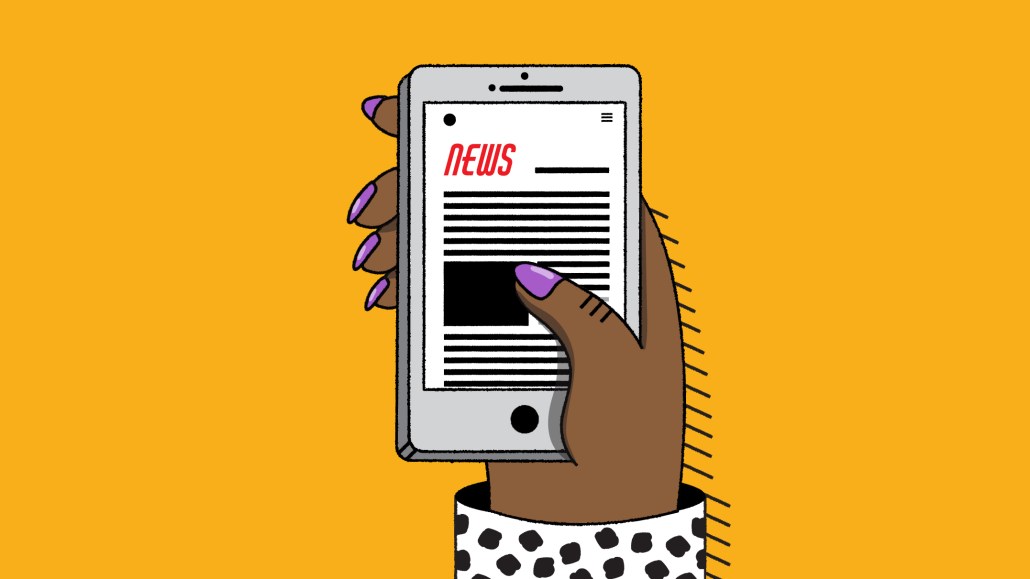The ‘reliability and quality’ of news content plays a significant role in achieving brand safety, new study finds

The public’s perception of news may not be at a high-water mark, but recent research out of IPG’s MAGNA unit, in partnership with Disney’s Ad Sales unit, indicates that news content still delivers value for advertisers because of the way news is valued by consumers.
In a study titled “No News is Bad News: Ads in News & Other Types of Content,” the bottom-line finding is that the source of the news a brand appears in is more important than the content around the ad. In other words, quality and reputable journalism — what Joshua Lowcock, and global brand safety officer with IPG Mediabrands and chief digital officer, UM, calls “Capital J journalism” — can help a brand resonate better, and in turn brands should consider supporting reputable journalism to a greater degree.
It’s no coincidence that this sentiment comes at a time when the public has been hungry for pandemic-related information and news. News viewers are “a smart and curious audience, who are interested in learning about the world around them. Tailoring your message accordingly matters and trustworthiness matters,” said Asaf Davidov, vp of measurement and insights, Disney Ad Sales. Likewise, news content “is just as effective as non-news content, and in some instances more impactful because you’re aligning yourself with trustworthiness as a pretty important component,” he added.
Other findings from the study, which focused on Disney’s news products including all content out of the ABC News division (including World News Tonight), ESPN and other streaming services, include:
- Guidance on ad messaging subtleties between hard news and softer or more culture-driven news. In hard news, a more direct, product focused ad message delivered higher brand impact, with favorability rising 10% over benchmarks, research intent up 5% and purchase intent up 7%. In race and culture news, on the other hand, a storytelling approach for brands yielded 11% better favorability 10% better purchase intent.
- News perceived as “heavy” isn’t necessarily a bad place for brands to appear adjacent to; the study showed it can actually drive brand impact. Brand favorability rose 7% and intent to recommend the brand rose 5% from ads in news perceived as “heavy” or “sad” by participants.
- 57% of the study’s respondents felt that brands should vet the news source before advertising on it, but that rose to 61% among more affluent households (incomes of $100K+) and dropped to 52% among households making $35K or less.
MAGNA and Disney are both taking the study’s findings out to their respective clients. “It aligns with our broader approach on media responsibility, which is ensuring that making this connection to where you spend your money matters,” said Lowcock. “We now have demonstrable evidence that when you spend your money in places that matter, you get a better brand outcome. They’re two good narratives.”
Both Davidov and Lowcock dismissed concerns that the research could be used by less reputable news outlets to try to legitimize themselves. “The underlying thing our research is around is that the reliability and quality of the source is important,” explained Lowcock. “But there’s separate work we’re doing to validate the reliability and credibility of that finding. High ratings do not translate to reliability.”
More in Media

Digiday+ Research: Publishers’ growing focus on video doesn’t translate to social platforms
Major publishers have made recent investments in vertical video, but that shift is not carrying over to social media platforms.

Technology x humanity: A conversation with Dayforce’s Amy Capellanti-Wolf
Capellanti-Wolf shared insight on everything from navigating AI adoption and combating burnout to rethinking talent strategies.

How The Arena Group is rewriting its commercial playbook for the zero-click era
The company is testing AI-powered content recommendation models to keep readers moving through its network of sites and, in doing so, bump up revenue per session – its core performance metric.








